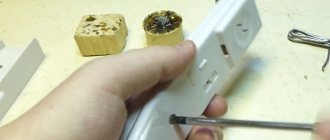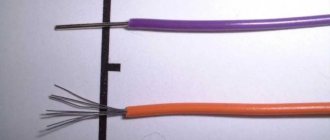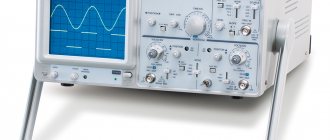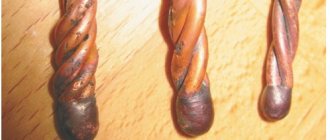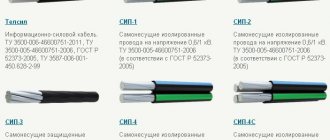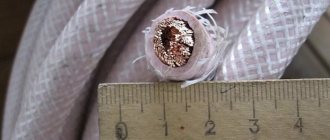05/08/2020 497 Electrical wiring and electrical circuits
Author:Ivan
Piercing clamps for self-supporting insulated wires are used to insert cables into residential or industrial premises from the main line. Their purpose is to provide high-quality contact between the core of an electrical insulated wire. Regardless of the cross-section of the conductor, the device allows you to protect the connection point from various external factors.
[Hide]
Types, their structure and principle of operation
Varieties and types of clamps for connecting wires work on a similar principle and have almost the same design. Products 2x16, 4x16 and others provide serial and parallel connections. In the first case, the connection is made using a clamp, which is mounted in different connectors. Protective dielectric caps are installed on the exposed cable ends. In the case of a parallel connection, it is necessary to use special clamps, thanks to which a diversion from the main line is organized.
The electrical connection can be made by piercing the outer insulating layer of the self-supporting cable. For this purpose, pyramid-shaped cloves are used. When making a puncture, they qualitatively fix the joint, preventing moisture from entering it.
The product itself has the following device:
- Frame. It will be sealed or waterproof. The first option is more relevant.
- Internal terminal element. It is made of one or several symmetrical plates equipped with spikes in the form of a cone or pyramid. They are installed in each slot.
- Fastening mechanism. This component is based on the use of a shear calibrated bolt head.
- Auxiliary systems for opening the contact elements of the product. They are used for emergency shutdown of the device.
- Tightening screw for fixing the conductor.
- Eyelet for installing SIP.
- The contact area on which the main core is mounted.
- The protective cap installed on the SIP contributes to high-quality insulation of the conductor.
- Eyelet for laying the main core.
A lubricant is located directly in the body, sealing the puncture site. Thanks to the lubricant, the possibility of the cable coming into contact with air or water is eliminated.
If the device for piercing the SIP wires does not have a bolt for dismantling, then the cable is disconnected by biting it off.
The Elektro House channel talked about the design features of products for fixing SIPs.
ZOI
Branch clamps with an insulation layer are designed for connecting neutral or phase mains with a voltage of up to 1 kW to a high-voltage line. The wire section is suspended directly on the clamp itself. Puncture devices are installed on the power lines and tightened using a special shear screw head. This ensures optimal force for fixing the teeth to the conductor, which will ensure high-quality contact and avoid damage. If necessary, the device can be dismantled using a wrench by unscrewing the lower head, which will remain intact.
ZZZRB IEK
Clamps of this type are used to branch one or two cables from the main line. This type of connection is used in facilities characterized by low humidity, where water cannot enter the device. The product labeling indicates the purpose of the clamp, as well as the number of conductors for the branch.
Devices with a shear head are designated as C, and the presence of the fraction “/” indicates the range of wire cross-sections on the main and secondary lines. The fundamental difference between this type of product is that piercing elements are available only on the main cable. On the branch it is necessary to dismantle the insulating layer.
Photo gallery
Photos of different types of devices.
Product type ZOI
Clamp class ZOZRB IEK
Manufacturers
Leading companies producing valves are Ensto, Niled and others.
Ensto
The Finnish company Ensto produces fittings for all types of SIP. Lightweight models are available, made of plastic, as well as those made of durable alloys for harsh working conditions. A feature of the piercing clamps produced by the company is the pyramidal design of the teeth, which increases the contact area and reduces the penetration of teeth into the wire, which reduces its damage. This contact part is similar in characteristics to clamps in the form of dies.
Niled
The French company Niled is the main supplier of fittings for SIPs in Russia. A characteristic feature of the products is adaptation to local conditions. Insulation piercing devices for domestic small-section wires have been developed for the Russian market. The range of supplies meets the technical requirements of RAO UES divisions.
Pros of use
Description of the benefits of using and installing such devices:
- The consumer has the opportunity to work with a high voltage electrical network. By means of a clamp, a branch is made from the main self-supporting cable, without de-energizing the line.
- It is possible to connect conductors whose cores are made of various metals, for example, aluminum and copper. But it is important that these cables are single-core.
- Possibility of control of fixation thanks to the breaking head or using a dynamometer. In the first case, the element is made of aluminum. If the head breaks, this indicates that the tension has reached the desired level.
- The removal procedure is simplified by using a second bolt.
- Most modern models are equipped with a sealed housing. This parameter is checked by the manufacturer by applying high voltage to the product.
- Possibility of compensation of temperature expansions.
- Speed of installation work.
- A wide range of cable types that can be connected using this method.
The EKF channel spoke in more detail about the dangers associated with the use of this type of device.
Design of cable piercings
- Frame. The specific operation of the puncture requires its increased strength and resistance to atmospheric factors. Therefore, reinforced polymers or duralumin are used for its manufacture.
- Connecting plates. The peculiarity of their design is in the teeth, which pierce the cable insulation, providing electrical contact.
- The bolts are tight. Depending on the modification of the puncture, 1 - 2 pieces. Heads are shear-type, that is, this fastener is intended for one-time use.
- Caps. Once installed in place, they completely cover the ends of the SIP, which may stick out from the outlet clamps. This ensures the tightness of the connections.
What are the benefits of using punctures?
The technology of installation work is simplified, since there is no need to cut the SIP cable. Reliable, sealed electrical contact. Possibility of connecting a branch to a line without removing voltage from it
It is important if you consider how much time, for example, a summer resident needs to spend to find a local electrician, and even to persuade him to turn off the power to the network.
Installation features
Before installing and using the clamps, you need to take into account the mistakes that consumers make during installation:
- Do not try to unscrew the head after it has been screwed in. It only works to close it; it cannot be locked again. If the fastening is incorrect, the screw must be changed.
- It is not allowed to install more than one core into the product. The contact will be unreliable.
- It is not allowed to connect the cores of the SIP wire during installation - this violates safety regulations and increases the likelihood of a short circuit and fire.
When connecting the SIP piercing clamp, you must use dielectric wedges.
Installation instructions for piercing clamps
To install the product, perform the following steps:
- The wire itself from the common line is being prepared. Depending on the type of network - 220 or 380 volts, the cable will consist of two or four conductors. In the first case it is zero contact and phase, and in the second case it is zero and three phases.
- As a rule, the conductors are intertwined with each other; for ease of connection, each element should be separated in turn. To do this, you will need a special dielectric wedge; if it is not available, you can use a wooden block or lath. It is important that the product is durable and small in size.
- The wedge is installed between the main SIP and the remaining cables. The bundle is then untwisted in the opposite direction to the weave. You need to make a few turns to connect the piercing clamp for the SIP.
- The product is being installed. The design of this device is made in such a way that the main terminal for the main conductor will be through. It is used to connect to a continuous cable. The terminal element, intended for branching from the main line, is firmly closed at one end with a cap. Therefore, you can install it on one side.
- After installing the clamping part on the main line, the free terminal is installed until it stops. First, you should carefully straighten the conductor itself or cut off its bent part. It is cut so that the edge of the power wire, which is installed in the clamp, remains straight.
- When making connections, be sure to follow the color coding of the cables. If the SIP has a blue contact, then the same conductor is connected to it through the product.
- When both cables, branch and main, are in the clamp, use a wrench to tighten the screw on the piercing product. There are two heads next to the bolt, one on top of the other. The top one must be tightened, since it is the one that presses the plate. As a result of this action, the contact elements are pushed through and cut through the insulating layer. The top head is a break-away design so it will come off on its own when the correct torque is reached.
User Anna Shchekina talked about installing the clamping product.

